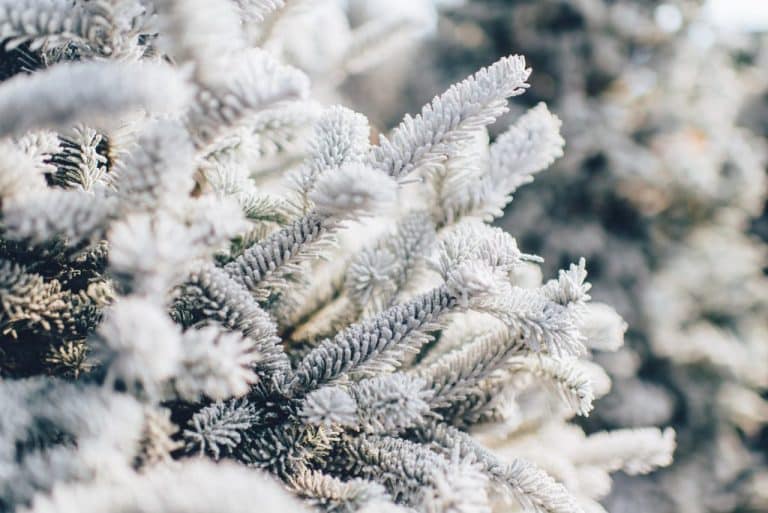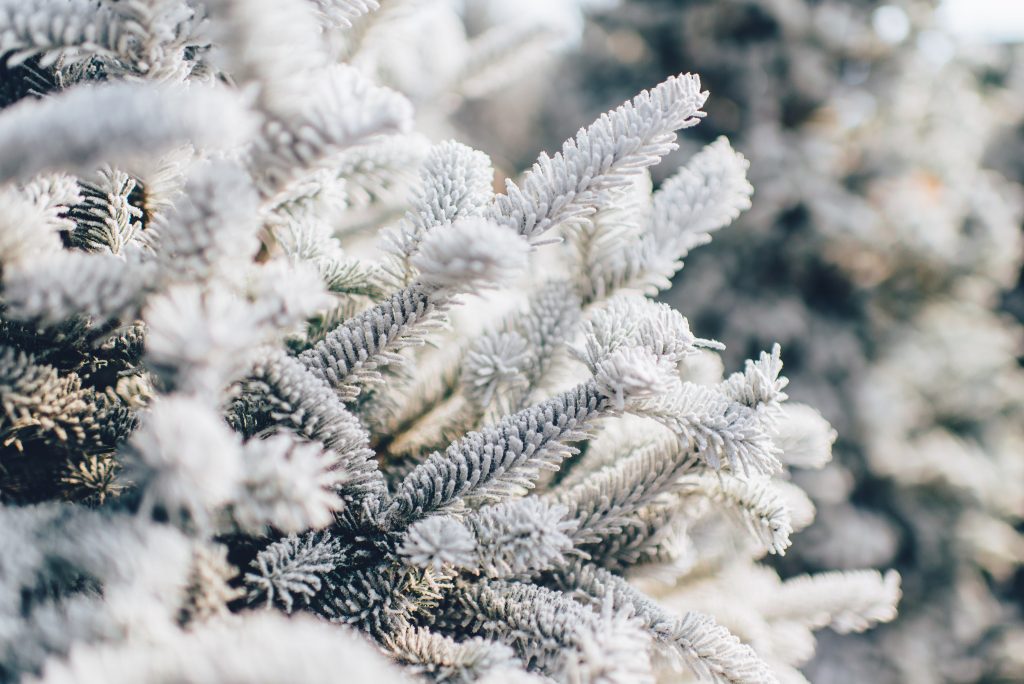There is the loveliest trend in Provo right now of flocking one’s Christmas tree. “Right now” might be misleading—Provo is awash in midcentury modern houses, and families have been flocking their trees since the fifties. But flocked trees are having a moment. If driving up and down the streets, gazing through people’s front windows at their incandescent Christmas trees sounds fun, a person can really make a night of it in Provo. (Guilty.)
I adore a nicely flocked tree, as well as its seventies analog, the stark white Christmas tree, in which a surprising number of my friends have indulged this year. I had my eye on a gorgeous, snowy artificial tree, but it cost well in excess of $800, and this is not the year for that sort of spendiness. Neither is it the year for disproportionate thrift; I saw a bleached version at Savers for $23, but my daughter said it looked “contagious.” We settled on a pretty seven-footer from Costco and are adorning it with white ornaments, some shaped like fruit, to remind us of Jesus Christ.
And it came to pass that I [Lehi] beheld a tree, whose fruit was desirable to make one happy. And it came to pass that I did go forth and partake of the fruit thereof; and I beheld that it was most sweet, above all that I ever before tasted. Yea, and I beheld that the fruit thereof was white, to exceed all the whiteness that I had ever seen. (1 Nephi 8:10-11)
Of course, not everyone construes the fruit that Lehi tasted to mean Jesus Christ. Growing up, I believe I was taught that it represented eternal life. I no longer read it that way, because I understand that the tree itself symbolizes Mary. As a teenager who woke up at 5am on weekdays to do a little recreational scripture study (a.k.a. Seminary), I was taught to parse Lehi’s vision of the tree of life somewhat differently. We learned that it symbolized Jesus Christ. This was never particularly resonant with me, but as I say, it was really early in the morning and I wasn’t asking a lot of questions.
I understand Lehi’s vision differently now, and I’m not sure why it took me so long to put two and two together. When Nephi asks see what his father saw, a heavenly guide grants him his righteous desire.
And it came to pass that the Spirit said unto me: Look! And I looked and beheld a tree; and it was like unto the tree which my father had seen; and the beauty thereof was far beyond, yea, exceeding of all beauty; and the whiteness thereof did exceed the whiteness of the driven snow. (1 Nephi 11:8)
And when he wants to know the meaning of the white and beautiful tree, Nephi is shown the mother of the Son of God. She is exceedingly beautiful and white. (Keep reading—it’s extraordinary.)
Mary is the tree is the Mother in Heaven. I’d like to high-five every single person who flocked their Christmas tree this year. Some folks may have done it in heartfelt devotion to Heavenly Mother; others may just dig a beautiful white tree. It all works for me. Flock on, good people, flock on!







8 Responses
You do not disappoint. I love that you’ve turned flocked trees into an expression of Yuletide feminism. You win.
If you haven’t read this article about Nephi and his Asherah, you’ll enjoy the Mother/tree connections: http://publications.mi.byu.edu/publications/jbms/9/2/S00003-50be458eb2b313Peterson.pdf
Thank you for putting that link here–Peterson’s article changed the way a lot of people read the BoM, I think, and I really do wish it were included in our church curriculum. At least make it very available to seminary students! At least leave copies of it lying around in our temple foyers!!!
Love this connection between tree and Mary and Heavenly Mother. (And flocking). Thanks, Emily!
Isn’t that the best way to read the Lehi’s dream story?!? I’m just waiting for a day to teach it like that in Sunday school.
Oh, wow. I’ve read Peterson’s article, and I’ve thought of the fruit as “the love of God”, but I didn’t connect the groves of Asherah/Lehi’s dream to the Christmas tree tradition, and I hadn’t thought of the fruit as being personified by Jesus. I definitely hadn’t connected with the imagery of Mary being the tree of life in such a deeply personal way before now.
Emily, thank you.
So much love for this! I’ll be teaching my boys a little lesson about this today. Thank you for reminding me!
Insightful, I’m almost bothered these ideas didn’t occur to me at some point they’re so in-your-face. Thanks for sharing.